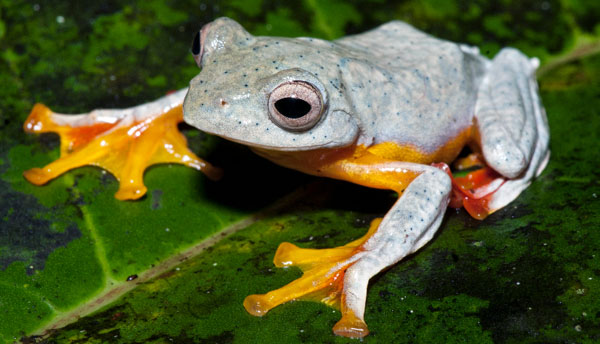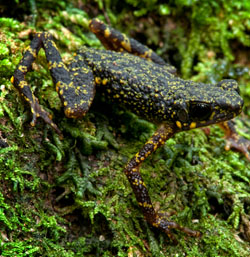Malaysia’s ‘megadiverse’ biology to be explored, conserved with new grant

LAWRENCE — Imagine traversing a pristine cloud forest on an isolated mountaintop. Everywhere, nature brims with wildlife that is unique to the range you’re hiking. Many creatures you can find nearby never have been described by science — they’re “undiscovered.” Beyond this place, the animals around you are unknown. Your job is to gather examples of this rich biodiversity and share what you find with the world.
 Chan Kin Onn, doctoral student at the University of Kansas Biodiversity Institute and Department of Ecology and Evolutionary Ecology, has trekked through such panoramas in Malaysia, his “megadiverse” home country, carrying out surveys of undiscovered species. Now, through a new $20,000 grant from the National Geographic Society, Chan will focus on revealing the hidden diversity and riverscape genetics of reptiles and amphibians in Northeastern Peninsular Malaysia.
Chan Kin Onn, doctoral student at the University of Kansas Biodiversity Institute and Department of Ecology and Evolutionary Ecology, has trekked through such panoramas in Malaysia, his “megadiverse” home country, carrying out surveys of undiscovered species. Now, through a new $20,000 grant from the National Geographic Society, Chan will focus on revealing the hidden diversity and riverscape genetics of reptiles and amphibians in Northeastern Peninsular Malaysia.
In some ways, the work is a continuation of Chan’s childhood preoccupation with nature.
“I've always had the urge to explore and ‘catch stuff’ for as long as I can remember, and Malaysia is great for that because we have a lot of beautiful habitats all over the country,” Chan said. “You don’t have to travel far to find a nice patch of forest to hike or a stream to swim in. Whenever I could, I’d always make trips to forests to try to find cool stuff. When I was younger, it was mostly bugs that intrigued me, but now it’s amphibians and reptiles.”
Remarkably, since 2003, Chan has participated in field research in Malaysia resulting in the discovery of 78 new species — more than have been described in the previous 105 years. This work has helped boost the nation’s amphibian and reptile count by more than 25 percent.
“Malaysia isn’t a big country by any means, but what makes us special and megadiverse is that our country harbors an exceptionally high number of species within a relatively small area,” Chan said. “The Malaysian mindset about our natural world is paradoxical. On one hand, we love being outdoors and enjoying nature; on the other hand, our sense of conservation is rather lacking. That’s what a lot of our research is centered upon, educating the people about the world around them — and hopefully inspiring them to conserve it.”
Chan credited his unique success discovering new Malaysian species to scant competition and disciplined fieldwork.
“Malaysian biodiversity is definitely under-researched due to the lack of manpower and expertise,” he said. “There just aren’t a lot of people, especially in the younger generation, who want careers in the natural sciences. I suppose it’s perceived as being less glamorous and doesn't pay as much as careers in the corporate world. Our group has discovered so many species mainly because we explore new places and we question and scrutinize every specimen we come across. A lot of new species were overlooked merely because they were misidentified or assumed to be another.”
While Malaysia has untouched settings teeming with wildlife, there also are regions where development threatens to wipe out valuable habitat and entire species. Some of Chan’s recent work halted a proposed airport expansion that would have destroyed vital habitat on Tioman Island and elsewhere thwarted quarrying by cement firms that might have eradicated rare species of geckos.
“As a biologist and conservationist, we’re always at odds with human development. Unfortunately, we’re on the losing side as more areas are being destroyed than conserved. However, it’s encouraging to see our research has bore some fruit. The challenging part is to relay our research to the general public in a comprehensible and convincing manner. “
Chan’s work will focus on shallow-water islands and three species-rich mountain chains — the Bintang, Timur and Titiwangsa ranges — that contain multitudes of reptiles and amphibians new to science.
“Mountain ranges provide a very different and unique mixup to the environment,” Chan said. “Mountains alter topology and climate, and the organisms that reside therein. Organisms develop specializations to adapt to these alterations and can eventually evolve to become new species. Mountain ranges also act as physical barriers that prevent genes from mixing, which can also lead to the formation of new species.”
In addition to his fieldwork, Chan will bring the latest in genetic analysis to the task of cataloguing Malaysian biodiversity, using KU labs to sequence DNA and examine species relationships and population genomics. Using genomic data in concert with a technique called “ecological niche modeling,” Chan plans to hone in on four species of river-dwelling frog. He’ll investigate how genes flow within and between these geographically separate frog populations along complex networks of rivers and down through their generations to reconstruct the evolutionary history of these species.
During the grant work, Chan will prioritize research of creatures whose habitat is being destroyed by tourism projects or agriculture and call attention to their plight.
“We look for highly specialized species that occur in very small and limited areas, as they’re the ones that are most fragile and threatened,” he said.
Chan’s National Geographic grant partners include researchers at KU, La Sierra University and the Universiti Sains Malaysia.
Photos: Malaysia is a "megadiverse" site of undiscovered species. Images courtesy KU News Service.